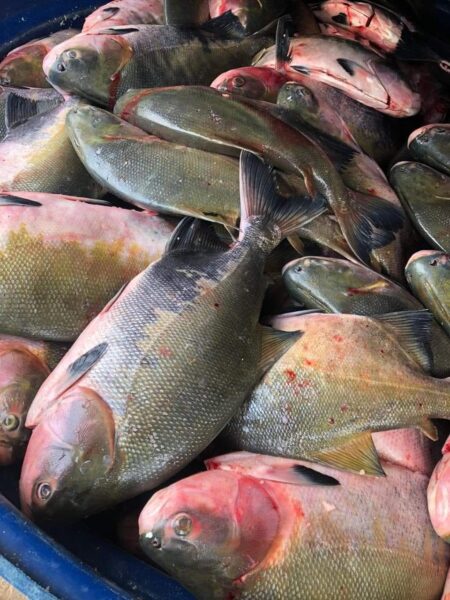The Tambaqui, also known as the black pacu or giant pacu, is a large, fascinating freshwater fish native to the lush, tropical river systems of South America.

The Tambaqui, also known as the black pacu or giant pacu [Photo: Rufus]
This fish captivates anglers with its size and strength, as well as ecologists and locals who admire its unique diet, impressive adaptability, and critical role in aquatic ecosystems.
APPEARANCE AND PHYSICAL CHARACTERISTICS
The Tambaqui (Colossoma macropomum), is a striking fish with a tall, compressed body that closely resembles the well-known piranha, though it is much larger and has a gentler nature.
Growing up to 1.1 meters (3.6 feet) in length and weighing up to 44 kilograms (97 pounds), it is one of the largest-scaled fish in South America.
The Tambaqui’s body colouration varies based on water type, often appearing darker in blackwater rivers and lighter in whitewater rivers.
Typically, the lower half of its body is a deep blackish shade, while the upper body displays hues of grey, olive, or yellow.
Its teeth are molar-like and ideal for crushing seeds and nuts—a trait that reflects its dietary preferences.
NATURAL HABITAT: WHERE TO FIND THE TAMBAQUI IN GUYANA
In the wild, Tambaqui thrive in the whitewater and blackwater rivers of South America. In Guyana, they inhabit the rich, nutrient-laden waters of rivers like the Essequibo and other floodplain regions.
These fish are known to migrate, especially during spawning, moving from whitewater rivers to seasonally flooded forests and back.

A Rupununi Photo
TAMBAQUI’S DIET AND ECOLOGICAL ROLE
One of the Tambaqui’s most fascinating characteristics is its diet. Unlike other large fish, Tambaqui are primarily frugivorous, meaning they feed on fruits and seeds, which makes them crucial for seed dispersal.
During the flood season, up to 98% of their diet consists of fruits from angiosperm trees that drop seeds into the water.
This feeding behaviour not only provides sustenance for the fish but also supports forest regeneration by spreading seeds throughout their habitat.
In the low-water season, when fruits are scarcer, Tambaqui relies on zooplankton, wild rice, and, occasionally, small aquatic animals like snails and insects.
MIGRATION AND REPRODUCTIVE PATTERNS
The Tambaqui is a migratory fish that moves in large schools during the breeding season. Spawning occurs primarily between November and February in the nutrient-rich whitewater rivers, where they seek out woody shorelines or grassy levees.
After spawning, the schools disband as adults return to the flooded forests. Juvenile Tambaqui remain near vegetation in these forests until reaching sexual maturity around two years of age or at a size of 60 cm.
These seasonal movements ensure the survival of the species and contribute to the ecosystem’s health by promoting biodiversity.
ADAPTABILITY: SURVIVING LOW OXYGEN, VARIABLE SALINITY, AND PH
Tambaqui is remarkably resilient, surviving in diverse conditions that would challenge many fish species. They have specialised gills and vascularised swim bladders that allow them to breathe air when oxygen levels in the water drop.
Young Tambaqui can even tolerate brackish water, although high salinity can impede growth.
Additionally, their bodies can withstand pH fluctuations, enabling them to move between black and whitewater streams without harm. This adaptability makes them ideal candidates for aquaculture and commercial fishing operations, where they thrive and grow quickly under managed conditions.
References
- https://animalia.bio/tambaqui
- https://en.wikipedia.org/wiki/Tambaqui







